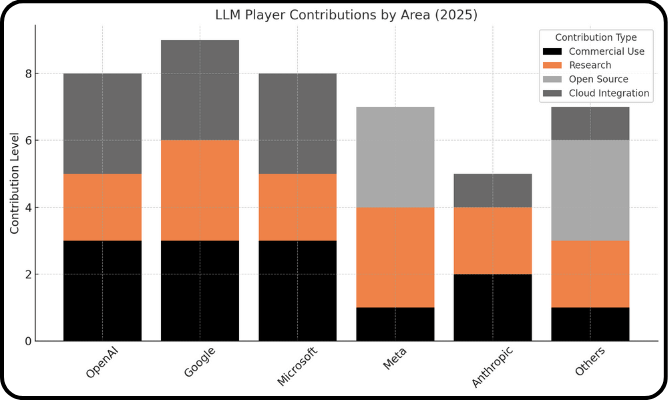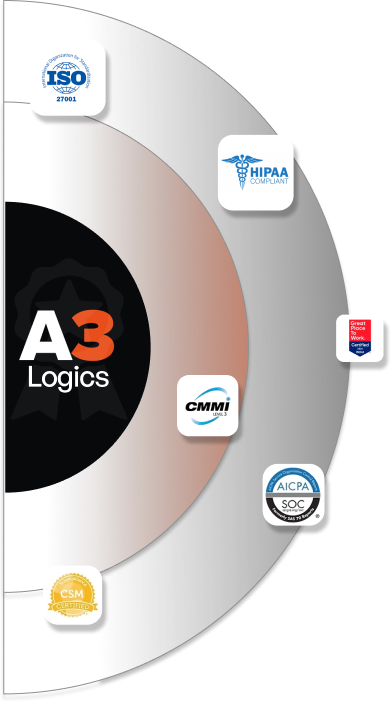Are you thinking about investing in the field of LLMs? Without a doubt, Large language models have completely transformed the field of artificial intelligence and assisted most of the industries through deep learning techniques and come up with human-like texts. We all know how organizations around the world are today using AI for different needs and this is where LLM development becomes highly crucial to enhance the overall operations.
But if you are not certain about what LLM is going to bring to the table for you, then we have all the answers covered for you below. Read on and get complete clarity about what LLMs are and how it is going to help your sector of service.

Table of Contents
Large Language Models: An Overview
Large language models (LLMs) are complex AI systems designed to interpret, synthesize, and modify human language. They are designed on transformer architecture, which allows them to analyze enormous volumes of text data effectively. Unlike traditional models, LLMs can manage context and nuance, making them particularly suitable for natural language processing (NLP) tasks. Below are the essential elements of LLM, check it out.
Scale
Often with billions or even trillions of parameters, large language models (LLMs) are defined by their enormous scale. Their great size lets them efficiently catch intricate linguistic patterns and correlations inside the data they handle. The many factors let LLMs grasp subtleties, context, and language nuances that smaller models could overlook. Using this size, LLMs can perform several jobs with great accuracy, from text production to translation. Their performance and adaptability are improved by the capacity to handle large data sets, which qualifies them for a broad spectrum of uses in many sectors.
Training Data
The effectiveness of LLMs largely stems from the diverse datasets used during their training. These models are trained on vast and varied collections of text, including books, articles, websites, and other written materials. This extensive training data exposes LLMs to different linguistic styles, contexts, and domains, allowing them to learn the intricacies of human language. By encountering a wide array of vocabulary, grammar, and syntax, LLMs develop a robust understanding of how language functions in various scenarios.
Generative Capabilities
One of the defining features of LLMs is their generative capabilities, which allow them to create coherent and contextually appropriate text based on input prompts. These models utilize their extensive training to generate human-like responses, making them invaluable for applications such as chatbots, content creation, and automated customer service. The ability to produce text that closely resembles natural language enables LLMs to engage users in a conversational manner, enhancing user experience.
Transfer Learning
Transfer learning is a crucial feature of LLMs that enhances their versatility and performance across different applications. After the initial training on large, diverse datasets, LLMs can be fine-tuned for specific tasks using smaller, task-specific datasets. This process allows them to adapt their general language understanding to more specialized contexts, improving accuracy and relevance. For example, an LLM training on general language data can be fine-tuned to excel in legal document analysis or medical text interpretation. This adaptability not only saves time and resources in model training but also ensures that organizations can leverage existing LLMs for various applications without starting from scratch.
Unsupervised Learning
LLMs utilize unsupervised learning techniques, which allow them to learn from unstructured data without the need for explicit labels or annotations. This approach particularly useful because it enables the models to process vast amounts of text data efficiently, extracting patterns and relationships without extensive manual input. By analyzing the co-occurrence of words and phrases in context, LLMs develop an understanding of grammar, semantics, and contextual nuances. LLMs’ self-learning allows continuous performance improvement with more data, making them highly scalable and adaptable.
Importance of LLM Development
As a pivotal aspect of AI, Large language model development is crucial for businesses aiming to leverage these models for improved efficiency and innovation. The ability to automate tasks, generate content, and analyze data can lead to significant operational improvements.
The importance of large language models can be underscored by some compelling statistics that highlight their capabilities and the growing interest in LLM development.
- Parameter Count: For instance, OpenAI’s GPT-3 model boasts a staggering 175 billion parameters, showcasing the scale at which these models operate.
- Training Data: LLMs are trained on extensive datasets, often comprising billions of documents, allowing them to learn diverse linguistic features.
- Market Growth: The global AI market is projected to reach $390 billion by 2025, with LLMs playing a significant role in this growth.
- Performance Improvement: LLMs can improve prediction accuracy by over 80% in various NLP tasks compared to traditional models.
- Efficiency Gains: Businesses implementing LLMs report a reduction in operational costs by up to 30%, thanks to automation and enhanced decision-making capabilities.
How do LLMs Work?
Understanding how LLMs function is vital for grasping their potential applications and benefits. These models utilize complex algorithms and architectures to process and generate language effectively.
Mechanisms of LLMs
- Transformer Architecture: LLMs are based on transformer models, which include an encoder and a decoder. This architecture allows for parallel processing of data, significantly improving training speed.
- Word Embeddings: LLMs use multi-dimensional vectors to represent words, enabling them to recognize relationships and contextual meanings effectively.
- Self-Attention Mechanism: This mechanism allows LLMs to assess the relevance of different words in a sentence, which is crucial for understanding context.
Learning Techniques
- Unsupervised Learning: LLMs learn from unstructured data, adjusting parameters based on patterns in the training data.
- Fine-Tuning: After initial training, LLMs can be fine-tuned with specific datasets to enhance performance in targeted applications.
LLMs in Different Industries
The versatility of LLMs has led to their adoption across various sectors, each benefiting uniquely from their capabilities.
Healthcare
- Clinical Documentation: LLMs assist in automating patient records and summarizing clinical notes, saving time for healthcare professionals.
- Patient Interaction: Chatbots powered by LLMs improve patient communication and engagement, providing immediate responses to inquiries.
Education
- Personalized Learning: LLMs can tailor educational content to individual learning styles, enhancing student engagement.
- Tutoring Systems: They power intelligent tutoring systems that provide real-time assistance to students, helping them understand complex topics.
Marketing
- Content Creation: LLMs automate the generation of marketing copy, ensuring consistency and freeing up creative resources.
- Sentiment Analysis: They analyze customer feedback and social media to gauge public sentiment, guiding marketing strategies.
Finance
- Fraud Detection: LLMs analyze transaction patterns to identify anomalies and potential fraud, enhancing security.
- Report Generation: They automate financial reporting, ensuring accuracy and saving time for analysts.
Legal
- Document Review: LLMs streamline the review of legal documents, identifying relevant information quickly.
- Legal Research: They assist in legal research by summarizing case law and pulling pertinent information from vast databases.
Advantages and Limitations of LLMs
While LLMs offer numerous benefits, they also come with challenges that organizations must navigate.
Advantages
Scalability
Large language models (LLMs) excel in scalability, allowing them to process and analyze vast amounts of data efficiently. This characteristic makes them particularly suitable for organizations of all sizes, from startups to large enterprises. As businesses grow and their data needs increase, LLMs can be scaled up to accommodate these demands without significant changes to the underlying architecture.
This flexibility enables organizations to leverage LLMs for various applications, such as customer service automation, content generation, and data analysis, without worrying about limitations in capacity. Furthermore, LLMs can be deployed in cloud environments, allowing for dynamic resource allocation based on real-time needs. This scalability not only enhances operational efficiency but also supports cost-effective solutions. It enables businesses to adapt quickly to changing market conditions and user requirements.
Versatility
LLMs are renowned for their versatility, capable of performing a wide range of tasks across different domains. From generating coherent text to translating languages and summarizing content, these models can adapt to various applications with ease. This adaptability stems from their extensive training on diverse datasets, allowing them to understand context and nuance in language. Organizations can deploy LLMs for multiple purposes, such as creating chatbots for customer interaction, automating report generation, and even assisting in creative writing.
This multifaceted capability reduces the need for multiple specialized models, streamlining processes and improving efficiency. Moreover, as LLMs continue to evolve, their ability to learn and adapt to new tasks enhances their value. It makes them indispensable tools for businesses seeking to innovate and stay competitive in a rapidly changing environment.
Limitations
Bias
Despite their advantages, LLMs are not without limitations, one of the most significant being bias. These models can inadvertently inherit biases present in their training data, leading to skewed or inappropriate outputs. Since LLMs learn from vast amounts of text sourced from the internet, they may reflect societal biases related to race, gender, and other sensitive issues.
This can result in harmful stereotypes being perpetuated or inaccuracy in outputs that affect decision-making processes. Addressing bias in LLMs requires careful curation of training datasets and ongoing monitoring of model outputs to ensure fairness and accuracy. Organizations must be proactive in identifying and mitigating these biases to uphold ethical standards and maintain trust with users, making bias a critical consideration in LLM development and deployment
Resource Intensive
The development and deployment of LLMs can be resource-intensive, presenting a significant challenge for many organizations. Training these models requires substantial computational power, often necessitating the use of high-performance graphics processing units (GPUs) & large-scale data storage solutions. This can lead to high operational costs, particularly for smaller companies or those with limited budgets. Additionally, the energy consumption associated with running LLMs can contribute to environmental concerns. This prompts organizations to consider sustainability in their AI strategies. The complexity of managing LLM infrastructure also requires specialized expertise, which may not be readily available in all organizations. As a result, while LLMs offer powerful capabilities, the resource demands can pose barriers to entry and limit their accessibility for certain users and applications.
The Future of LLMs
The future of LLMs is promising, with ongoing advancements expected to enhance their capabilities and applications.
Enhanced Accuracy
Ongoing developments in training methods will shape the future of large language models (LLMs), hence greatly improving their accuracy and dependability. While reducing biases, researchers are creating sophisticated algorithms and techniques enabling LLMs to learn from more varied data sets.
Techniques such as reinforcement learning from human feedback and improved optimization strategies will allow models to produce more exact predictions and create more contextually relevant replies. Large language models will be useful in crucial industries, including healthcare, finance, retail and legal.
Broader Applications
As LLMs evolve, their applications will broaden significantly, penetrating new industries and use cases. Beyond traditional sectors like marketing and customer service, LLMs will find utility in emerging fields such as robotics, autonomous vehicles, and personalized education. For instance, they could facilitate real-time language translation in international business settings or enhance user experiences in virtual reality environments.
This expansion will drive innovation across various domains, enabling organizations to leverage LLMs for unique solutions that meet specific challenges. The flexibility of large language models will make them adaptable to an increasing array of tasks, further solidifying their role in future technology.
Multimodal Capabilities
The integration of multimodal capabilities represents another exciting trend for the future of language models. The designing of upcoming models are to process not just text but also images, audio, and video. It allows for richer interactions and a more comprehensive understanding of context. For example, LLMs could analyze a video and generate descriptive text or respond to spoken commands in a more nuanced manner.
This capability will enhance applications in areas like content creation, virtual assistance, and interactive gaming. It therefore paves the way for more immersive and engaging user experiences.
Ethical and Responsible AI
As LLMs become more prevalent, the focus on ethical and responsible AI will intensify. Developers and organizations will prioritize transparency and accountability, working to eliminate biases and ensure fairness in AI outputs. Standards and regulations may emerge to govern the use of large language models, guiding developers in ethical practices.
This commitment to responsible AI will foster public trust and encourage broader adoption, as users gain confidence in the technology’s reliability and ethical implications. Addressing these concerns will be crucial for the sustainable development of large language models and their integration into society.
Real-Time Adaptation
Future LLMs will probably include real-time adaption features that let them learn and develop always from user interactions. Using feedback loops, these models can change their replies depending on user preferences and contextual signals. LLMs will be able to offer greater and more tailored experiences through this dynamic learning, hence improving their use in sectors like tailored marketing and customer support. Real-time adaption will guarantee LLMs remain relevant and in line with user needs, hence increasing involvement and satisfaction.
Collaboration with Human Intelligence
LLMs’ future will also witness increased cooperation between artificial and human intellect. LLMs will be cooperative assistants, so improving human capacity in certain sectors instead of replacing human roles. For instance, in creative sectors, LLMs can help authors by producing thoughts or writing material; human professionals hone and complete the result. By using LLMs’ efficiency for regular activities, this collaboration will improve output and innovation, enabling people to concentrate on more high-level decisions and creative activities.
Final Take
Hopefully, you are clear about all the aspects related to Large language models that represent a significant leap in AI technology. It is important that you use it right as it comes with immense potential of completely changing the world of how to interact with the machines to process information as required.
If you are thinking about how to move ahead with the same, then you must consider connecting with the LLM development company experts to help you with LLM implementation. The experts are going to understand your business model and help you with the solution accordingly to not only help you enhance productivity but boost returns as well. This is where A3Logics can make a big difference and help you make the most out of Large language models. Connect now!







